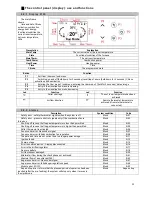
8
Picture 2.3:Exhaust duct
The room in which heating body will be mounted should not have aspirators because they can reduce pressure in the
environment.
It is strictly forbidden to close all the air openings.
The exhaust duct should be cleaned at least once a year; we recommend that you perform a thorough cleaning of the
exhaust channel and its connection.
After a period of not being used and before the activation, check whether there are any obstructions
⚠
ATTENTION: The exhaust duct has to be built in accordance with the provisions of the standard
.
⚠
ATTENTION: Use the adequate tool to check whether the chimney has the minimal suction power of 10 Pa.
2.2.1
The smoke exhaust towards the outer wall
One solution that can be used includes placing the pellet furnace near the outer wall of the house so that the exhaust
gases are released directly to the outside (Figure 2.4). Some of the notes set forth by the standard for this type of system
configurations are listed below:
-
Always make sure that there is a valve for inspection (i) to enable regular cleaning procedures and removal of
moisture that can form;
-
The end element on the chimney (T) has to be such to be wind and water resistant;
-
Please note that the pipe is properly insulated in the section that passes through the wall.
If the pipe for the removal of exhaust gases is located outside, it must be made of double wall and stainless steel to
provide greater resistance to atmospheric conditions, as well as the proper temperature of exhaust gases themselves.
2.2.2.
Smoke outlet at the roof through the traditional chimney
Exhaust gases from the furnace can be removed via a traditional chimney already built (Figure 2.5), if it meets the
standards required. The standard highlights the main characteristics of a good chimney (C), which are summarised below:
-
Proper insulation, before most in the outer part exposed to atmospheric conditions;
-
The constant inner radius (no segments with smaller radius);
-
It must be made of a material which is resistant to high temperatures, the effects of the combustion products
and to the corrosive effects of moisture which may occur;
-
Generally in the vertical position, without departing from the vertical angles greater than 45 °.
It is recommended that the base of the chimney to be equipped with a chamber for collecting of solid matter i.e.
moisture (R). The chamber has to be accessible through air-tight door (I).
H>0.50m
H>0.50m
Picture 2.4:The smoke exhaust towards the outer wall
Figure 2.5:Smoke outlet at the roof through
the traditional chimney
It is recommended to follow the guidelines laid down by standards in relation to the size and radius of the chimney (C).
In any case, never use exhaust duct with internal radius of less than 100 mm.
In the case of exhaust ducts of larger radius, a steel pipe (A) has to be placed inside the chimney bricks or mortar (C),
as shown in Figure 2.6.
Steel pipe must be isolated by a suitable heat-resistant materials, such as rock wool or vermiculite (B), and must be
separated from the outer edge of the chimney.











































